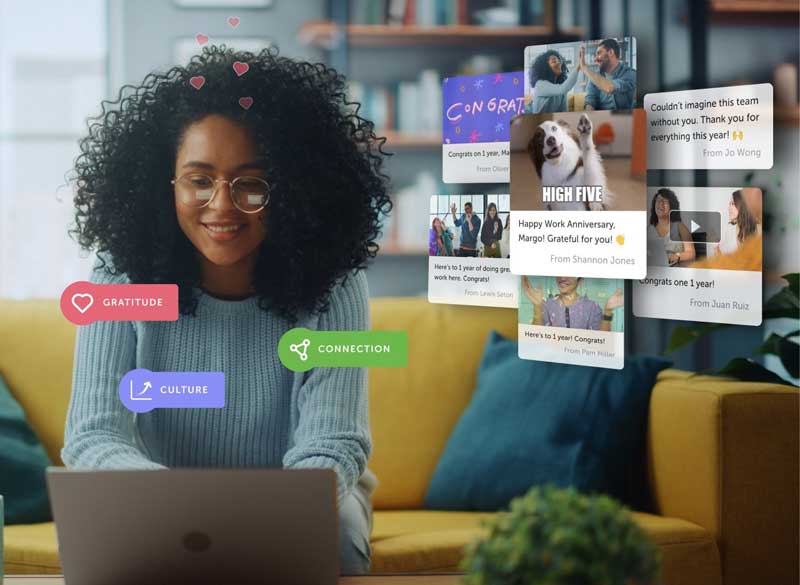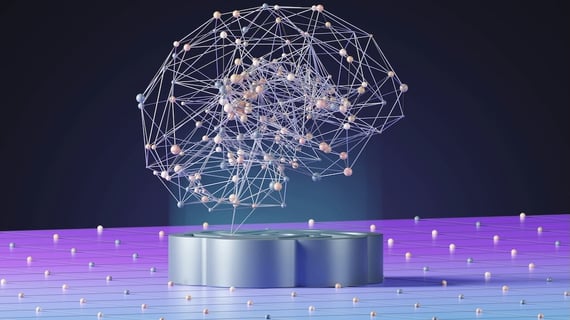In today’s increasingly digital workplace, a simple gesture of appreciation can go a long way—and eCards are making that easier than ever. More than just a quick “thank you,” eCards provide a powerful, low-effort way to recognize your teammates and build stronger, more emotionally intelligent teams.
When we talk about workplace success, emotional intelligence (EQ) is just as important—if not more—than IQ. EQ helps teams collaborate, communicate, and connect. And digital appreciation tools like eCards play a surprising role in developing it.
This article explores the connection between emotional intelligence and eCards, and how using tools like Kudoboard can help your team build a stronger, more human-centered workplace culture—one thoughtful message at a time. Let’s dive in!
What is Emotional Intelligence?
The term “emotional intelligence” or “EQ” refers to one’s ability to recognize and manage emotions. This definition includes personal emotions and those felt by other people.
Imagine: Two colleagues start arguing about a work-related project. Each is convinced their idea is best and wants to see it pursued. One of the colleagues, Paul, has a low EQ and starts shouting. He doesn’t realize how angry he is. The other colleague, Mary, has a high EQ. She understands that John is upset, runs a quick internal calculation, and says, “John, I see this is important to you. Let’s take a moment to breathe. Then we can talk about a path forward.“
Increase emotional intelligence with eCards
Boost employee EQs and enjoy better communication, collaboration, and retention
The 5 Characteristics of Emotional Intelligence
Emotional intelligence can be broken down into five characteristics: Self-awareness, self-regulation, self-motivation, empathy, and social skills. Let’s take a closer look at each:
Self-Awareness: The ability to recognize one’s strengths and weaknesses
Self-Regulation: The ability to channel negative emotions into positive outcomes
Self-Motivation: The ability to set goals and commit oneself to achieving them
Empathy: The ability to put oneself in another person’s shoes and feel what they feel
Social Skills: The ability to communicate ideas in respectful ways and listen to others
Highly emotionally intelligent people will be proficient in all five characteristics. Fortunately, each can be learned and/or improved upon, which means anyone can elevate their EQ.

Why is Emotional Intelligence Important in the Workplace?
Now that we know what emotional intelligence is, let’s talk about why it’s important. Here are four reasons to develop and display emotional intelligence in the workplace:
Better Communication
Emotionally intelligent people are better communicators. This is a valuable skill because effective communication is proven to boost productivity, collaboration, and profits.
Once you and your team learn to communicate effectively, you’ll be able to share ideas, suppress negative emotions, and handle personal conflict in positive ways. In other words, you’ll be able to contribute to a more productive work environment.
Stronger Relationships
Strong communication skills lead to better workplace relationships.
After all, communication is the foundation of connection. When employees communicate well, they tend to enjoy each other’s company more, experience less conflict, and do better work.
They also collaborate better, which can lead to improved performance. Speaking of which…
Improved Performance
Research suggests that 90% of top performers have high emotional intelligence. Moreover, emotional intelligence training can increase company profits by as much as 29%.
To put the second statistic into perspective, a $10M company could boost profits by almost $3M a year by simply developing its employees’ EQs. That’s a lot of money!
The question is, why do emotionally intelligent people perform better? It’s pretty simple: They collaborate better with teammates, don’t let their emotions goad them into poor decisions, and manage stress more effectively. They tend to engage more in their work, too.
Higher Retention
Finally, high emotional intelligence builds workplace culture. This is true for all the reasons above: better communication, stronger relationships, and improved performance.
Employees don’t look for new jobs when they have good relations with their colleagues and are fulfilled in their work. Because of this, EQ can have a significant impact on retention.
Since it can cost $1,500 to replace an hourly worker and up to 150% of an employee’s annual salary to replace a technical position, the fact that EQ reduces turnover is a big deal.
How Ecards Unlock the Benefits of Emotional Intelligence at Work
An ecard, sometimes stylized e card, is a digital greeting card. People usually create them on websites like Kudoboard and send them via email, social media, or a digital link.
Regardless, eCards help unlock emotional intelligence in the workplace by harnessing the power of digital appreciation and employee recognition. Here’s how:
Show Employees Your Appreciation
eCards give managers an easy way to appreciate employees. They simply choose a template, write a personalized message, and send the card to the intended recipients. Piece of cake.
This kind of top-down communication encourages managers to think about their teams, recognize their employees’ strengths, and communicate thoughts and emotions in clear, succinct ways. Put simply, eCards help managers become more emotionally intelligent.

Remind Employees to Appreciate Each Other
eCards will help you improve your EQ, but what about your employees?
As it turns out, eCards can improve their emotional intelligence, too. How so? Well, employees can send each other eCards, which will allow them to experience all of the benefits listed above.
When an employee sends an ecard to a colleague, they have to think about their teammates’ contributions, reflect on their relationship, and communicate their feelings.
Allow Companies to Express Gratitude in New Ways
eCards will also give you new and exciting ways to say, “Thanks!” and “You’re Awesome!“
For example, tools like Kudoboard allow users to send written messages to each other. But said users can also attach memes and original images—or even shoot videos.
From an emotional intelligence perspective, the ability to attach media to an ecard will make you and your employees think, “What’s the best way to recognize this person?” Then they can create content that aligns with the ecard recipient’s preferred recognition methods.
Ah, we feel your EQ rising already!
Get Creative With Employee Feedback
Last but not least, eCards are a fun alternative to standard (i.e. boring) employee feedback.
Ditch the traditional report card and replace it with an engaging ecard. Then use the space to write about each employee’s strengths, mention areas for improvement, and otherwise coach your team to greater success. Or step up your game and share feedback through video instead.
You can flip this idea around too, and let your employees share feedback with you via a digital card. What do they like about your management style, their working environment, and your overall company? What do they think you can improve on? You won’t know until you ask.
Whatever you decide to do, eCards stimulate EQ growth by facilitating important conversations that build stronger relationships, level up performance, and create stronger company culture.
Make the Best eCards With Kudoboard: A 5-Step Process
eCards and group cards will help you and your employees become more emotionally intelligent human beings. But you might be wondering, “How do I create an amazing ecard?” Use Kudoboard!
What is Kudoboard?
Kudoboard is an employee engagement platform that helps you make and send eCards and group cards.
You can use it to create digital slideshows, online collages, and other cool things as well. But that’s a conversation for another day. Back to eCards and your EQ scores…
Once you sign up for an affordable Kudoboard membership, you can celebrate your team’s accomplishments, recognize their birthdays and milestones, encourage peer-to-peer recognition, and more. Basically, you’ll have the tools to truly inspire your employees.

How Does Kudoboard Help Teams?
Kudoboard will help your company unlock all of the benefits of EQ, as we described above. But it has a few advantages over other ecard platforms that might claim the same thing:
Kudoboard is Intuitive
First, Kudoboard is extremely easy to use.
You don’t have to be a world-class designer to make incredible eCards with Kudoboard. Our industry-leading platform is jam-packed with professionally designed templates.
All you have to do is choose one that fits the occasion, like a “Birthday” template to recognize an employee’s special day or a “Celebration” template to recognize a national holiday. Then add your own text, memes from your favorite TV show, a picture of a funny animal—it’s up to you.
Kudoboard is Fun to Use
Kudoboard isn’t just intuitive, it’s fun.
Seriously, you’ll enjoy making eCards or group cards with our platform, which is something you probably can’t say about other forms of employee recognition. Designing custom plaques? Barf!
What makes Kudoboard so fun? The wealth of eye-catching templates that you can easily personalize. Plus, Kudoboard lets users add animations, memes, images, and videos to every ecard. So, you can flex your creative muscles. What’s more fun than that?
Kudoboard is Peer-to-Peer
Peer-to-peer recognition is 35.7% more likely to have a positive impact on financial results than manager-only recognition. Huh, that sounds like a stat you should pay attention to, doesn’t it?
Guess what—Kudoboard makes it easy to facilitate peer-to-peer shoutouts.
Here’s the process: create a new board, ask employees to praise their colleagues, and watch as employee engagement, motivation, and performance go up. Like, way up.
Kudoboard Builds Good Habits
While you can use Kudoboard to send one-off eCards, it wasn’t designed for this.
Kudoboard is most effective when used as a consistent employee recognition tool. In other words, don’t use it to say “Congratulations!” once. Use it to recognize your employees on a weekly—if not daily—basis via personal notes, fun images, and other supportive content types.
If you take this piece of advice, you and your team will build a habit of recognition. This will only benefit your company, leading to bigger goals, higher revenue numbers, and more success.
Kudoboard is More Than Just eCards
Yes, Kudoboard was built to send virtual greeting cards and inspire employees. But that’s not all it can do. Kudoboard is equipped with other features to improve the ecard experience.
For example, you can attach digital gift cards to every eCard you send. You can also have your eCards turned into physical books and wall posters. Whether you want to recognize an employee, a friend, or a family member, Kudoboard can help you make the act more special.
Create eCards in 5 Easy Steps
Ready to make eCards with Kudoboard? Just follow this simple, five-step process:
1. Choose a Template
First, choose a professionally designed ecard template from the Kudoboard library.
We have templates for birthday cards, thank you cards, Christmas cards, employee departure cards, online memorial cards, team celebration cards, and over a dozen other scenarios.
Choose one to suit your purposes. Then get ready to personalize your ecard with custom backgrounds, fonts, messages, media types, and whatever else you want.
2. Personalize Your Ecard
Now that you’ve chosen an appropriate template, you can customize it for your recipient.
Don’t skip this step! Yes, our templates look great “out of the box“. And, yes, customizing the template will require additional effort. But a little personalization goes a long way when it comes to employee appreciation. Plus, you won’t improve your EQ if you don’t personalize.
As described above, Kudoboard enables you to change backgrounds, fonts, messages, media types, and more. Get creative and make an ecard your coworkers or loved ones will enjoy.
3. Invite Others to Participate
Are you happy with your ecard? Good, now you can invite others to contribute.
Put yourself in your recipient’s shoes. They come to work, sit down at their desk, and fire up their computer. Before they put their nose to the grindstone, they get an email notification.
It’s the ecard you made for them. But instead of a single note, it contains 20—one from each of their coworkers. Your recipient reads through the heartfelt messages, smiles at the memories, and laughs at the GIFs. That one little email just made their entire day.
This is the power of group cards.
Kudoboard makes it easy to invite additional group card contributors. Send them an online link, which will give them 24/7 access so they can contribute at a time of their choosing.
4. Add a Digital Gift Card (If Desired)
eCards and group cards are great. eCards that include digital gift cards are better.
Kudoboard gives you two options when it comes to gift cards: You can pay for them with company funds, or you can ask employees to donate and pool the money together.
Either way, a lump sum will be sent to your recipient, which they can then redeem for a gift card to dozens of popular stores and restaurants or a prepaid Visa card. The lump sum can also be donated to charity if your recipient would rather spend the money to support a specific cause.
5. Deliver Your eCard or Group Card to Your Recipient
There’s only one thing left to do: send your ecard and watch your recipient smile.
eCards have the power to engage employees on a deeper level, motivate them to work harder, inspire them to greater performance, and keep them around for longer periods of time. Win!
And remember, if you really want to make your eCard special, you can convert it into a hardbound book or wall poster. Some people just need to hold things in their hands, ya know?
Build a Culture of Digital Appreciation for Your Company
Emotional intelligence is underrated—especially in a business context.
If you can increase your employees’ EQs, they’ll communicate better, perform at a higher level, and stick around for longer. Those are definitely benefits to strive for!
Fortunately, eCards can help with this. Thanks to tools like Kudoboard, you can create eCards to recognize your employees for their efforts and celebrate a special occasion. Doing so will encourage deeper thinking, more collaboration, better creativity, and ultimately, higher EQs.




